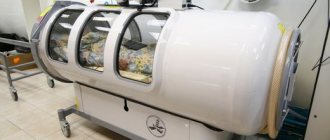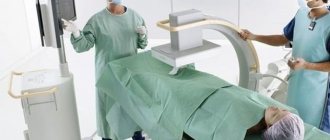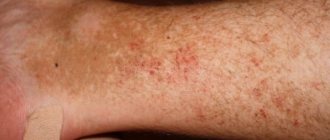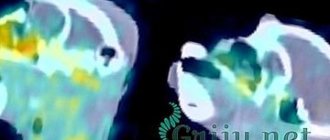Causes and mechanism of development of Itsenko-Cushing syndrome
Itsenko-Cushing syndrome is a broad concept that includes a complex of various conditions characterized by hypercortisolism. According to modern research in the field of endocrinology, more than 80% of cases of development of Itsenko-Cushing syndrome are associated with increased secretion of ACTH by pituitary microadenoma (Itsenko-Cushing disease). Pituitary microadenoma is a small (no more than 2 cm), often benign, glandular tumor that produces adrenocorticotropic hormone.
In 14-18% of patients, the cause of Itsenko-Cushing syndrome is a primary lesion of the adrenal cortex as a result of hyperplastic tumor formations of the adrenal cortex - adenoma, adenomatosis, adenocarcinoma.
1-2% of the disease is caused by ACTH-ectopic or corticoliberin-ectopic syndrome - a tumor that secretes corticotropic hormone (corticotropinoma). ACTH-ectopic syndrome can be caused by tumors of various organs: lungs, testes, ovaries, thymus, parathyroid, thyroid, pancreas, prostate. The incidence of drug-induced Cushing's syndrome depends on the correct use of glucocorticoids in the treatment of patients with systemic diseases.
Hypersecretion of cortisol in Itsenko-Cushing syndrome causes a catabolic effect - the breakdown of protein structures of bones, muscles (including the heart), skin, internal organs, etc., eventually leading to tissue degeneration and atrophy. Increased glucogenesis and absorption of glucose in the intestine causes the development of the steroid form of diabetes. Disorders of fat metabolism in Itsenko-Cushing syndrome are characterized by excessive fat deposition in some areas of the body and atrophy in others due to their different sensitivity to glucocorticoids. The effect of excessive cortisol levels on the kidneys is manifested by electrolyte disorders - hypokalemia and hypernatremia and, as a consequence, increased blood pressure and worsening degenerative processes in muscle tissue.
The heart muscle suffers the most from hypercortisolism, which manifests itself in the development of cardiomyopathy, heart failure and arrhythmias. Cortisol has a suppressive effect on the immune system, making patients with Cushing's syndrome prone to infections. The course of Itsenko-Cushing syndrome can be mild, moderate and severe; progressive (with the development of the entire symptom complex over 6-12 months) or gradual (with an increase over 2-10 years).
Causes of hypercortisolism
In some cases, the cause of hypercortisolism is a pituitary adenoma.
- Exogenous or drug-induced hypercorticism can be caused by long-term use of drugs containing glucocorticoid hormones (prednisolone, dexamethasone, etc.) in the treatment of any diseases, such as bronchial asthma, systemic lupus erythematosus, rheumatoid arthritis, etc. In such cases, it is necessary to reduce the dose of drugs to maintenance (minimum acceptable) to control this disease.
- Ectopic ACTH production is a condition in which tumors of various origins outside the pituitary gland produce adrenocorticotropic hormone, for example tumors of the lung, thymus, thyroid or pancreas.
- Tumors of the adrenal glands, and most often excess production of cortisol occurs with benign tumors of these glands (adenoma).
- Familial form of Itsenko–Cushing syndrome. In most cases, this disease is not inherited, but there is a hereditary syndrome of multiple endocrine neoplasia, in which a person has an increased likelihood of developing tumors, including the adrenal glands.
- Pituitary adenoma is a benign tumor of the pituitary gland, leading to overproduction of ACTH and, as a consequence, excessive production of cortisol by the adrenal cortex. Hypercorticism, resulting from damage to the pituitary gland, is actually called Itsenko-Cushing's disease. According to statistics, this disease is five times more common in women, and tumors of other endocrine glands are often detected simultaneously.
Symptoms of Itsenko-Cushing syndrome
The most characteristic symptom of Itsenko-Cushing syndrome is obesity, detected in patients in more than 90% of cases. The redistribution of fat is uneven, according to the Cushingoid type. Fat deposits are observed on the face, neck, chest, abdomen, back with relatively thin limbs (“a colossus with feet of clay”). The face becomes moon-shaped, red-purple in color with a cyanotic tint (“matronism”). Fat deposition in the area of the VII cervical vertebra creates the so-called “menopausal” or “buffalo” hump. In Itsenko-Cushing syndrome, obesity is characterized by thin, almost transparent skin on the backs of the hands.
From the muscular system, there is muscle atrophy, a decrease in muscle tone and strength, which is manifested by muscle weakness (myopathy). Typical signs accompanying Cushing's syndrome are “sloping buttocks” (reduction in the volume of the femoral and gluteal muscles), “frog belly” (hypotrophy of the abdominal muscles), hernia of the white line of the abdomen.
The skin of patients with Cushing's syndrome has a characteristic “marble” shade with a clearly visible vascular pattern, is prone to peeling, dryness, and alternates with areas of sweating. On the skin of the shoulder girdle, mammary glands, abdomen, buttocks and thighs, stripes of stretched skin are formed - stretch marks of a purple or cyanotic color, ranging from a few millimeters to 8 cm in length and up to 2 cm in width. Skin rashes (acne), subcutaneous hemorrhages, spider veins, hyperpigmentation of certain areas of the skin.
With hypercortisolism, thinning and damage to bone tissue often develops - osteoporosis, leading to severe pain, deformation and fractures of bones, kyphoscoliosis and scoliosis, more pronounced in the lumbar and thoracic spine. Due to compression of the vertebrae, patients become stooped and shorter. Children with Cushing's syndrome experience growth retardation caused by slower development of epiphyseal cartilage.
Disorders of the heart muscle manifest themselves in the development of cardiomyopathy, accompanied by arrhythmias (atrial fibrillation, extrasystole), arterial hypertension and symptoms of heart failure. These serious complications can lead to the death of patients. With Itsenko-Cushing syndrome, the nervous system suffers, which is expressed in its unstable functioning: lethargy, depression, euphoria, steroid psychoses, suicidal attempts.
In 10-20% of cases, during the course of the disease, steroid diabetes mellitus develops, which is not associated with lesions of the pancreas. This type of diabetes occurs quite easily, with a long-term normal level of insulin in the blood, which is quickly compensated by an individual diet and glucose-lowering medications. Sometimes poly- and nocturia and peripheral edema develop.
Hyperandrogenism in women, accompanying Itsenko-Cushing syndrome, causes the development of virilization, hirsutism, hypertrichosis, menstrual irregularities, amenorrhea, and infertility. Male patients exhibit signs of feminization, testicular atrophy, decreased potency and libido, and gynecomastia.
Development of the disease in children
Cushing's syndrome in children is diagnosed extremely rarely; it is considered a severe disorder of the endocrine system. Children most often become ill after the age of twelve, but sometimes the pathology occurs in preschool age.
This sympathocomplex develops very quickly, leading to irreversible changes in the child’s body, therefore the diagnosis and initiation of treatment measures must be immediate.
Due to metabolic disorders, children, like adult patients, suffer from obesity. Fat deposits form in the upper part of the body, the face becomes moon-shaped, and the skin takes on a purplish-red hue. If the disease occurs in a preschool child, then fatty tissue is distributed evenly throughout the body. Ninety percent of sick children experience growth retardation because the epiphyseal growth plates close prematurely. Due to obesity, this causes dehydration.
We recommend reading Keratomas - causes, treatment at home
In children with this diagnosis, puberty is delayed, but hair on the face and body grows intensively, like in men. In addition, hair begins to grow on the back and limbs. In male children, the penis and testicles develop more slowly; in girls, uterine hypoplasia occurs, ovarian function is disrupted, breasts do not grow, and menstruation does not begin.
Children with Cushing's syndrome also develop red or purple stretch marks on the abdomen, buttocks, thighs, and sides. The skin is dry and thin, easily wounded. Often there is damage by fungus, furunculosis, and ulcers. Acne appears on the face, chest and back. Spots similar to lichen appear on the limbs and torso. The skin on the buttocks is dry and cold to the touch.
Osteoporosis occurs in children, bone mass decreases, bones become brittle and often break. With a fracture, pain is mild or absent. Healing is accompanied by a large callus. Hypertension and tachycardia occur, electrolyte metabolism is disrupted, and hormonal disruption occurs. The younger the child, the higher the blood pressure readings. Neurological and mental disorders are noted:
- depression;
- emotional arousal;
- suicidal thoughts.
During the remission stage, psycho-neurological symptoms disappear.
Complications of Itsenko-Cushing syndrome
The chronic, progressive course of Itsenko-Cushing syndrome with increasing symptoms can lead to the death of patients as a result of complications incompatible with life: cardiac decompensation, stroke, sepsis, severe pyelonephritis, chronic renal failure, osteoporosis with multiple fractures of the spine and ribs.
An emergency condition in Itsenko-Cushing syndrome is an adrenal (adrenal) crisis, manifested by impaired consciousness, arterial hypotension, vomiting, abdominal pain, hypoglycemia, hyponatremia, hyperkalemia and metabolic acidosis.
As a result of decreased resistance to infections, patients with Itsenko-Cushing syndrome often develop furunculosis, phlegmon, suppurative and fungal skin diseases. The development of urolithiasis is associated with osteoporosis of the bones and the excretion of excess calcium and phosphates in the urine, leading to the formation of oxalate and phosphate stones in the kidneys. Pregnancy in women with hypercortisolism often ends in miscarriage or complicated childbirth.
Diagnosis of Itsenko-Cushing syndrome
If a patient is suspected of having Itsenko-Cushing syndrome based on amnestic and physical data and exogenous source of glucocorticoids (including inhalation and intra-articular) has been excluded, the cause of hypercortisolism is first determined. Screening tests are used for this:
- determination of cortisol excretion in daily urine: an increase in cortisol by 3-4 times or more indicates the reliability of the diagnosis of Itsenko-Cushing syndrome or disease.
- small dexamethasone test: normally, taking dexamethasone reduces cortisol levels by more than half, but with Itsenko-Cushing syndrome there is no reduction.
Differential diagnosis between the disease and Itsenko-Cushing syndrome allows a large dexamethasone test. In Itsenko-Cushing's disease, taking dexamethasone leads to a decrease in cortisol concentration by more than 2 times from the original; Cortisol reduction does not occur in the syndrome.
In the urine, the content of 11-OX (11-hydroxyketosteroids) is increased and 17-KS is decreased. There is hypokalemia in the blood, an increase in the amount of hemoglobin, red blood cells and cholesterol. To determine the source of hypercortisolism (bilateral adrenal hyperplasia, pituitary adenoma, corticosteroma), an MRI or CT scan of the adrenal glands and pituitary gland and adrenal scintigraphy are performed. In order to diagnose complications of Itsenko-Cushing syndrome (osteoporosis, vertebral compression fractures, rib fractures, etc.), radiography and CT scanning of the spine and chest are performed. A biochemical study of blood parameters diagnoses electrolyte disorders, steroid diabetes mellitus, etc.
Treatment of Itsenko-Cushing syndrome
With the iatrogenic (medicinal) nature of Itsenko-Cushing syndrome, gradual withdrawal of glucocorticoids and their replacement with other immunosuppressants is necessary. With the endogenous nature of hypercortisolism, drugs that suppress steroidogenesis (aminoglutethimide, mitotane) are prescribed.
If there is a tumor lesion of the adrenal glands, pituitary gland, lungs, surgical removal of the tumors is performed, and if this is not possible, unilateral or bilateral adrenalectomy (removal of the adrenal gland) or radiation therapy of the hypothalamic-pituitary region. Radiation therapy is often carried out in combination with surgical or drug treatment to enhance and maintain the effect.
Symptomatic treatment for Itsenko-Cushing syndrome includes the use of antihypertensive, diuretic, hypoglycemic drugs, cardiac glycosides, biostimulants and immunomodulators, antidepressants or sedatives, vitamin therapy, and drug therapy for osteoporosis. Compensation for protein, mineral and carbohydrate metabolism is carried out. Postoperative treatment of patients with chronic adrenal insufficiency who have undergone adrenalectomy consists of continuous hormone replacement therapy.
Forecast of Itsenko-Cushing syndrome
If treatment for Itsenko-Cushing syndrome is ignored, irreversible changes develop, leading to death in 40-50% of patients. If the cause of the syndrome is a benign corticosteroma, the prognosis is satisfactory, although the functions of a healthy adrenal gland are restored only in 80% of patients. When diagnosing malignant corticosteras, the five-year survival prognosis is 20-25% (on average 14 months). In case of chronic adrenal insufficiency, lifelong replacement therapy with mineral and glucocorticoids is indicated.
In general, the prognosis of Itsenko-Cushing syndrome is determined by the timeliness of diagnosis and treatment, the causes, the presence and severity of complications, the possibility and effectiveness of surgical intervention. Patients with Itsenko-Cushing syndrome are under dynamic observation by an endocrinologist; they are not recommended for heavy physical activity or night shifts at work.
Treatment
Treatment of Cushing's syndrome is aimed at eliminating the root cause of the disorder and normalizing hormonal balance. Treatment can be carried out using several methods:
- Drug therapy;
- Irradiation;
- Surgical intervention.
If treatment is not started within five years after the onset of the disease, then thirty to fifty percent of patients die.
Drug therapy
Treatment with medications is carried out comprehensively. The prescribed drugs help reduce the production of hormones by the adrenal cortex. Among the drugs prescribed are Mitotane, Aminoglutethimide, Metyrapone, Trilostane. Drug therapy is used in cases where surgery is impossible or has proven ineffective. If this is necessary, doctors also resort to symptomatic therapy, including taking glucose-lowering drugs, medications that lower blood pressure, and antidepressants.
We recommend reading Basalioma of the skin of the nose - causes, treatment, types
Radiation therapy
Irradiation is carried out if the pathology occurs due to a pituitary adenoma. Thus, the pituitary gland stops the secretion of hormones. Radiation therapy is carried out in combination with surgery or drug treatment. Radiation for pituitary adenoma should be carried out twice a year.
Surgical intervention
The effectiveness of surgical intervention ranges from seventy to eighty percent. In case of pituitary adenoma, it is removed. If the cause of the syndrome lies in a tumor of the adrenal cortex, then surgery is performed. In severe cases, two adrenal glands are removed, in which case the patient will need to take glucocorticosteroids for the rest of his life. The operation is not performed if there are contraindications such as severe concomitant diseases, the patient’s very serious condition, or age over seventy-five years.











